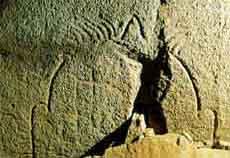- Home
- Megalithism in Morbihan
- Le Petit-Mont
- Petit-Mont Art
- In grave II
Inside the chamber, six of the eight pillars are decorated, as are the three preserved vertical girders on the northern side of the passage. Decorations are also found on the first capstone of the chamber, on a broken lintel in the passage and on several scattered components.
- Part of the decoration is classical, both as regards the overall style and sobriety (the three axe blades on the roof, the stylised axes, the crosier, the shield and the cupmarks that can be seen on the wall).
- Other panels display a number of "grids" reminiscent of Kercado or Mané-Kerioned in Carnac.
- The stele reconstructed from the broken lintel of the passage carried a large shield with a complex inner motif.
- Some of the interconnecting zigzag lines recall the "Gavrinis style".
In Grave II, the extensive re-use of slabs that had already been worked is noteworthy (of the specially carved slabs designed specifically for grave II).
- The chamber paving is a scutiform stele with no visible decoration but whose human like shape has been carefully fashioned.
- Another broken "stele-shield" with a crosier in the "chest" has been planted upside down to form part of the southern wall.
- The decorated slabs on the roof and passage chamber also display unusual positions.
Next slide
Previous slide
Polished stone axe heads on the roof of the chamber of cairn II.
"Tintin", the shield on the broken stele which was used to cover a part of the passage in the cairn II grave.
The reversed position of this splendid crosier shows that its support was turned upside down to help to build the cairn II chamber.


